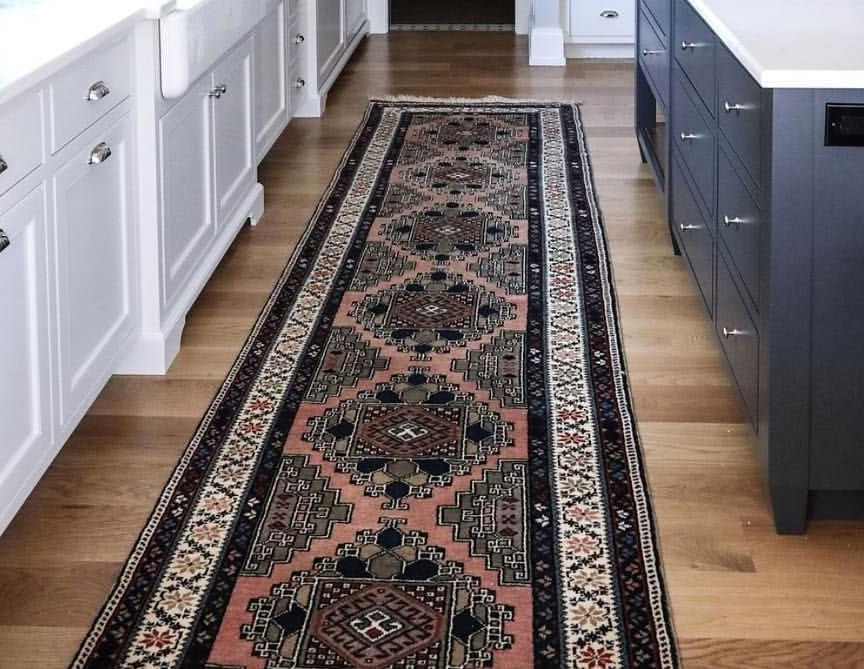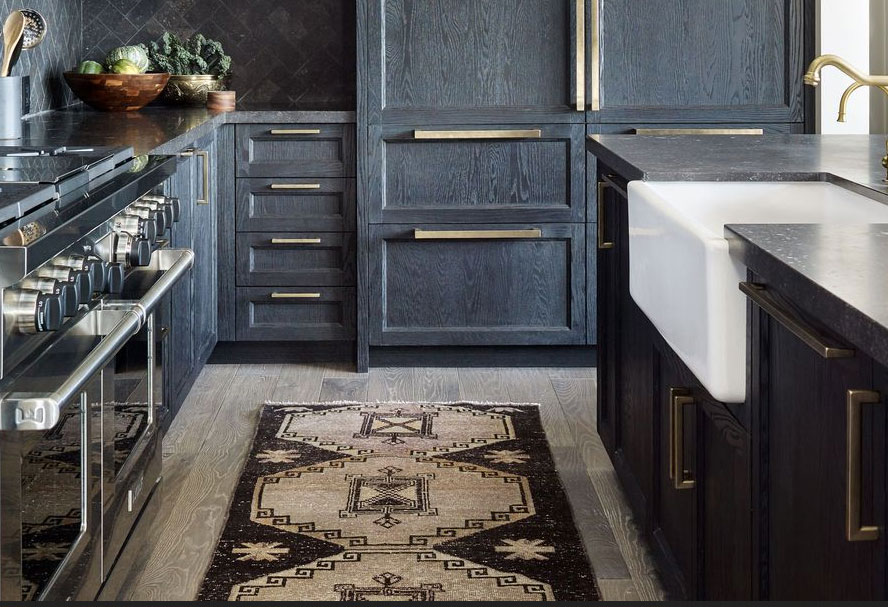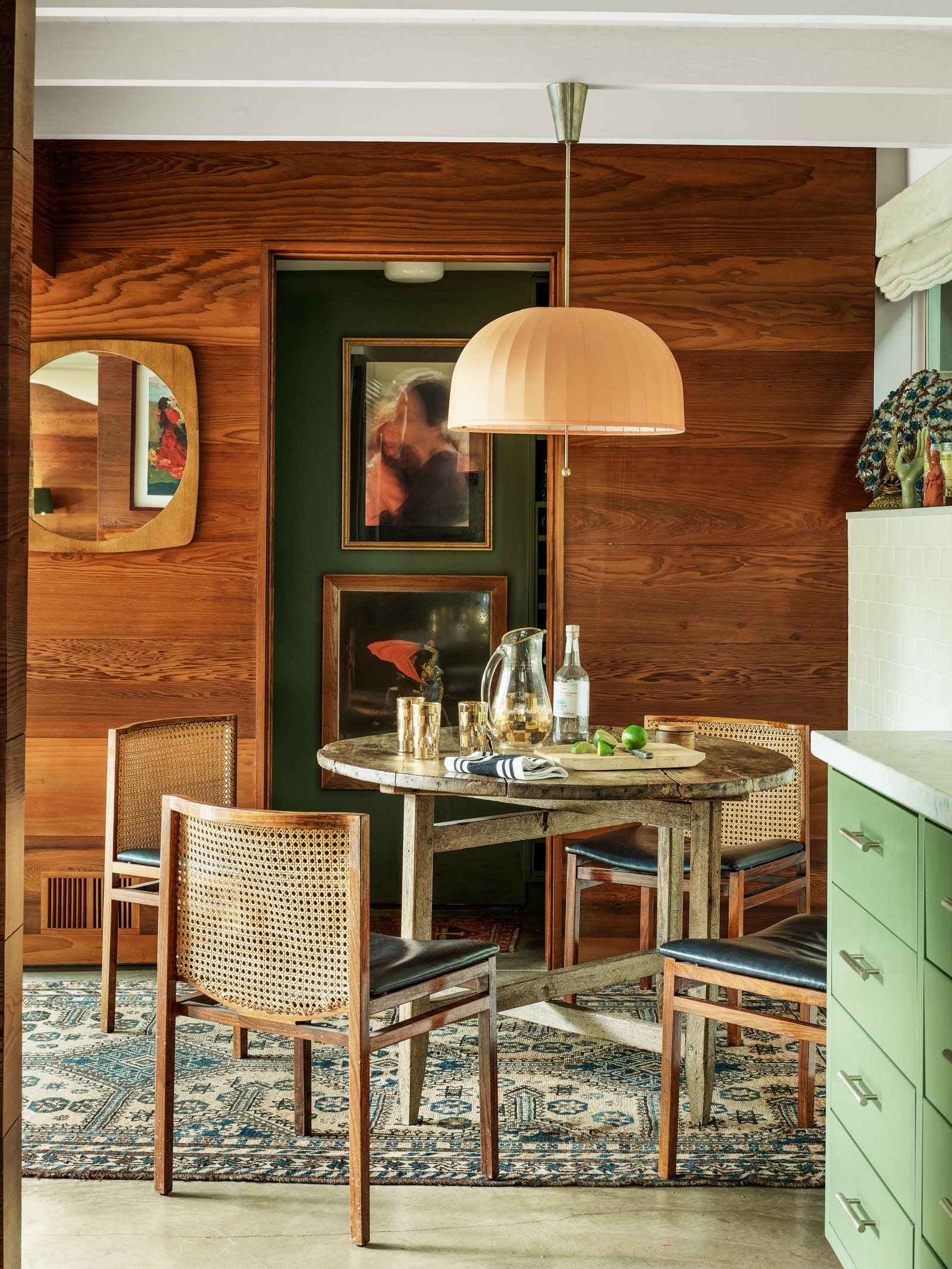Not long ago the idea of having a handwoven or hand-knotted rug in the kitchen or dining room was an unthinkable concept. Statement handwoven and hand-knotted rugs were reserved for formal rooms – living rooms, halls and bedrooms – not potentially “messy” food-related rooms. No longer. The last few years has seen an accelerating trend to make a fashion statement in kitchens and dining rooms with semi-antique (1930s-1950s) and vintage (1950s-2000) handmade rugs and the trend shows no signs of fading.
Handmade wool rugs are perfectly suited for kitchens and dining rooms. Wool is stain, flame and mold resistant, and despite the hype around synthetic rugs which often feature a printed design that fades or wears away, woven or hand-knotted wool rugs will last a lifetime and make a beautiful addition to kitchen and dining room décor. Read on for how to get the look, plus a few tips on rug care.
Rugs in Kitchens
Before this trend took off, rugs in kitchens were doormat sized inexpensive mats placed in front of the sink. Thankfully those days are over. Mat-sized rugs are out and going large is in. Interior designers and homeowners are choosing large-scale handmade rugs as statement pieces for kitchens and dining rooms. Traditionally sized handmade or hand-knotted runners were the first size seen in kitchens when the trend was in its early days, but the current on-trend look has evolved to the more desired “edge-to-edge” look in the area between counters or between a counter and a kitchen island. Although conventional rug sizing wisdom recommends a sizeable gap between rug edge and wall, the “edge-to-edge” look deliberately minimizes the gap.
One of our favorite examples of this look is in the home of Hollywood actress Dakota Johnson. Each room in her home features antique and semi-antique handwoven or hand-knotted rugs including her walk-in closet. Her kitchen features an edge-to-edge antique (1920s) West Persian Luri Tribal rug. The rug’s bold pattern works like a painting on the floor to allow the lettuce green kitchen cabinets to embrace the rug like a picture frame (a look also endorsed by interior designer Carla Fonts Hrncir who told Veranda magazine that “rugs are like art pieces that are laid on the floor”). Johnson’s adjacent dining nook features a semi-antique Persian rug in colors that create a narrative color balance with the kitchen cabinets. For a similar size and look to the rug in Johnson’s kitchen, consider our 4’10” x 5’10” antique Persian Heriz hand-knotted wool rug (Sh66322).
https://shahbanurugs.com/4-10-x5-10-Antique-Persian-Heriz-Smaller-Rare-Size-Natural-Wool-Good-Condition-and-Clean-Navy-Blue-Hand-Knotted-Oriental-Rug-66322.html
Rugs in Dining Rooms
Dining rooms are making a comeback due to Covid lockdown because more of us are realising the limitations of open-plan homes and returning to the concept of enclosed, multi-functional rooms where unrelated activities take place at different times of the day. With the comeback of the dining room comes the desire to make the dining room table a focal point by centering it on a rug.
Interior Designer Isabel Ladd encourages her clients to move away from the idea that semi-antique and vintage rugs are only suitable for formal spaces, because high foot traffic areas are no longer just “casual” spaces like the kitchen, mud room, or children’s rooms, but now include these new multi-function spaces. When choosing a rug for a dining area the number one consideration is size. When dining room chairs are pulled away from the table all four legs should still sit on the rug to avoid chairs teetering half on half off the rug. Other than that, there really is no other rule; choose a color or pattern that you love and consider the rug a “painting” on the floor.
Tips for using hand-knotted and handwoven rugs in kitchens and dining rooms
• Choose a wool semi-antique or vintage rug. Wool is durable and inherently mold, mildew, flame, and water resistant.
• It’s likely your kitchen has tile or hardwood flooring which means it’s essential to use a rug pad beneath your area rug to prevent the rug from slipping. We recommend a natural rubber pad backed with felt which will allow the rug to safely grip the floor.
• Choose a highly patterned rug for kitchens and dining rooms to disguise inevitable food stains until you have time to spot clean the rug.
• Keep a tempered spring steel wallpaper scraper in your kitchen to quickly scoop up any food that drops onto your rug. The thin flexible blades of “spring steel” wallpaper scrapers are ideal for lifting food cleanly and quickly.



